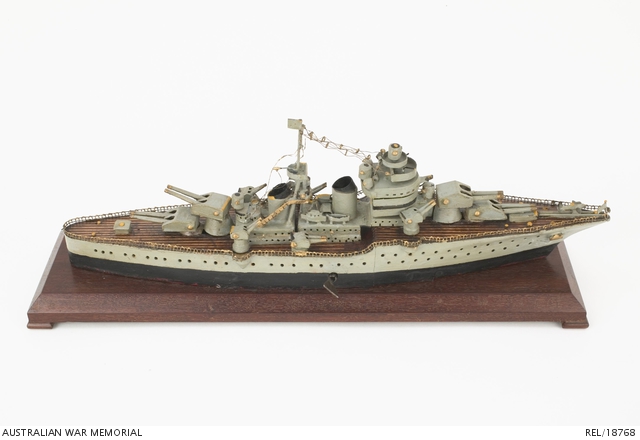| Accession Number | REL/18768 |
|---|---|
| Collection type | Technology |
| Object type | Model |
| Physical description | Metal, Paint, Wire, Wood |
| Maker |
Unknown |
| Place made | Australia: South Australia, Loveday Group Camps |
| Date made | 1943-1944 |
| Conflict |
Second World War, 1939-1945 |
Model of Japanese cruiser : Made by Japanese POWs at Loveday Prison Camp in South Australia





Naïve model of a Japanese cruiser with a wooden hull, superstructure, guns and deck, with deck railings and mast aerials made from gold painted flywire. The main deck has been fabricated from alternating dark and light wooden strips. The four large gun turrets front and rear can be swivelled and their guns raised by means of a small metal winding key set into the starboard side, while the six smaller turrets are fixed. Other details include a catapult seaplane mounted on the bow; four lifeboats and a searchlight mounted amidships; a pair of anchors; and flags fixed to the bow, the mast and the stern. Below the waterline, the hull is painted black while the remainder is in a green-grey with various parts picked out in yellow and gold. The model is mounted to a dark hardwood base, which the bow slightly overhangs. The model is not proportional to scale: her length is proportionately far too short for her width and for the height of the superstructure.
Model of a Japanese cruiser made from available materials by Japanese prisoners of war (POWs) at Loveday Prison Camp in South Australia, and given to S3202 Major Gordon E Whitehill of Newstead, South Australia, a member of the Garrison unit guarding the camp, in 1943-44.
Born on 5 January 1896, Major Whitehill had served as a Lieutenant with the 4th Pioneer Battalion during the First World War, enlisting on 2 August 1915 and returning to Australia on 19 June 1919. The identities of the Japanese POWs responsible for the model have not been recorded.